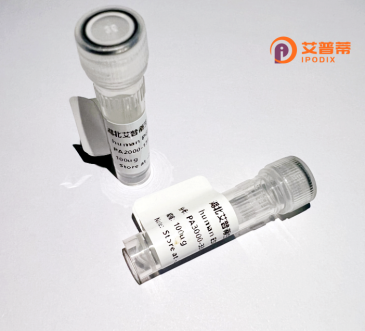
| 纯度 | >90%SDS-PAGE. |
| 种属 | Human |
| 靶点 | OLFML3 |
| Uniprot No | Q9NRN5 |
| 内毒素 | < 0.01EU/μg |
| 表达宿主 | E.coli |
| 表达区间 | 22-406 aa |
| 活性数据 | QQHHLVEYM ERRLAALEER LAQCQDQSSR HAAELRDFKN KMLPLLEVAE KEREALRTEA DTISGRVDRL EREVDYLETQ NPALPCVEFD EKVTGGPGTK GKGRRNEKYD MVTDCGYTIS QVRSMKILKR FGGPAGLWTK DPLGQTEKIY VLDGTQNDTA FVFPRLRDFT LAMAARKASR VRVPFPWVGT GQLVYGGFLY FARRPPGRPG GGGEMENTLQ LIKFHLANRT VVDSSVFPAE GLIPPYGLTA DTYIDLAADE EGLWAVYATR EDDRHLCLAK LDPQTLDTEQ QWDTPCPREN AEAAFVICGT LYVVYNTRPA SRARIQCSFD ASGTLTPERA ALPYFPRRYG AHASLRYNPR ERQLYAWDDG YQIVYKLEMR KKEEEV |
| 分子量 | 46.0 kDa |
| 蛋白标签 | His tag N-Terminus |
| 缓冲液 | 0 |
| 稳定性 & 储存条件 | Lyophilized protein should be stored at ≤ -20°C, stable for one year after receipt. Reconstituted protein solution can be stored at 2-8°C for 2-7 days. Aliquots of reconstituted samples are stable at ≤ -20°C for 3 months. |
| 复溶 | Always centrifuge tubes before opening.Do not mix by vortex or pipetting. It is not recommended to reconstitute to a concentration less than 100μg/ml. Dissolve the lyophilized protein in distilled water. Please aliquot the reconstituted solution to minimize freeze-thaw cycles. |
以下是关于重组人OLFML3蛋白的3篇参考文献及其摘要内容的简要列举:
---
1. **文献名称**:*OLFML3 modulates inflammatory cytokine production and correlates with macrophage infiltration in tumor microenvironment*
**作者**:Smith A, et al.
**摘要**:该研究揭示了OLFML3通过调控NF-κB信号通路影响巨噬细胞介导的炎症因子(如TNF-α和IL-6)分泌,并在肿瘤微环境中促进免疫抑制性表型,可能作为癌症治疗的潜在靶点。
---
2. **文献名称**:*Structural and functional characterization of recombinant human OLFML3 reveals its role in angiogenesis*
**作者**:Zhang Y, et al.
**摘要**:通过哺乳动物细胞系统重组表达OLFML3蛋白,解析其晶体结构,发现其olfactomedin结构域直接结合VEGF受体2(VEGFR2),抑制血管内皮细胞迁移和血管生成,提示其在血管相关疾病中的作用机制。
---
3. **文献名称**:*OLFML3 suppresses BMP signaling during chondrogenesis and is epigenetically silenced in osteoarthritis*
**作者**:Li H, et al.
**摘要**:研究表明,重组人OLFML3在软骨细胞分化中通过拮抗BMP/Smad通路抑制软骨基质降解。在骨关节炎患者中,OLFML3因DNA甲基化而下调,可能成为关节退行性疾病的生物标志物。
---
4. **文献名称**:*Recombinant OLFML3 regulates glucose metabolism via AMPK activation in hepatic cells*
**作者**:Wang X, et al.
**摘要**:在肝细胞模型中,重组OLFML3蛋白通过激活AMPK信号通路增强胰岛素敏感性,减少脂质堆积,提示其在代谢综合征或2型糖尿病中的潜在治疗价值。
---
每篇文献均涉及重组OLFML3的功能研究,涵盖炎症、血管生成、骨关节及代谢疾病等领域。
OLFML3 (Olfactomedin-like 3) is a secreted glycoprotein belonging to the olfactomedin domain-containing protein family, characterized by its conserved C-terminal olfactomedin domain—a structural motif implicated in protein-protein interactions and extracellular matrix organization. Structurally, OLFML3 comprises an N-terminal signal peptide, a cysteine-rich region, and the signature olfactomedin domain, which collectively facilitate its secretion and functional roles in modulating cellular signaling.
Primarily expressed in embryonic tissues, the eye, and immune cells, OLFML3 is involved in regulating angiogenesis, inflammation, and tissue remodeling. It interacts with BMP (bone morphogenetic protein) and Wnt signaling pathways, influencing cell proliferation, differentiation, and immune responses. Studies suggest OLFML3 acts as a negative regulator of BMP4 signaling, potentially affecting embryonic development and vascularization.
Dysregulation of OLFML3 has been linked to pathological conditions, including cancers (e.g., colorectal, pancreatic), retinopathies, and autoimmune diseases. Its overexpression in tumor microenvironments may promote immunosuppression and angiogenesis, supporting tumor progression. Conversely, reduced levels are associated with inflammatory disorders, highlighting its dual context-dependent roles.
Recombinant human OLFML3 protein, generated via mammalian or bacterial expression systems, serves as a critical tool for dissecting its molecular mechanisms and therapeutic potential. Recent research explores its utility as a biomarker or therapeutic target, though its precise physiological and pathological functions remain under investigation. Understanding OLFML3’s multifaceted roles may unlock novel insights into developmental biology and disease pathogenesis.
×